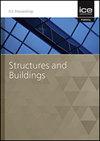地震爆炸荷载对钢筋混凝土结构的易损性分析
IF 1.4
4区 工程技术
Q3 CONSTRUCTION & BUILDING TECHNOLOGY
Proceedings of the Institution of Civil Engineers-Structures and Buildings
Pub Date : 2023-04-03
DOI:10.1680/jstbu.22.00165
引用次数: 0
摘要
在地震易发地区设计结构时考虑地震荷载是一种常见的做法。结构破坏的严重程度取决于地震的震级和结构的类型。有时,高强度地震会引发建筑物内部的爆炸性物质爆炸。这种荷载情景的组合可能导致结构的整体损伤增加。因此,研究多灾种荷载作用下结构的易损性分析是十分必要的。本研究主要讨论地震后爆炸荷载对钢筋混凝土结构的综合影响。结果表明,在地震和爆炸双重作用下,结构的损伤增大。此外,爆炸荷载作用后结构的地震诱发振动加剧。考虑到地震和爆炸荷载可能的荷载组合,对结构进行了参数化研究。此外,本研究还讨论了上述问题的数值解,加强了基础知识,并为结构工程师提供了对本研究中考虑的多灾害加载场景的更深入了解。本文章由计算机程序翻译,如有差异,请以英文原文为准。
Vulnerability analysis of earthquake driven blast load on the reinforced concrete structure
It is common practice in earthquake-prone areas to design structures with earthquake loading in mind. The severity of the structure's damage depends on the earthquake's magnitude and the type of structure. Sometimes, the high-intensity earthquake can trigger explosive materials to explode inside the structures. This combination of loading scenarios could lead to an overall increase in damage to the structures. So, it is essential to study the vulnerability analysis of the structures subjected to multi-hazard loading scenarios. This study mainly discusses the combined effect of the earthquake followed by the blast loading on the reinforced concrete structure. The results show that damage to the structure increases under combined earthquake and blast loading. Furthermore, the earthquake-induced vibrations in the structure intensify after the blast load. A parametric study of the structure is also performed, taking into account the possible load combinations of earthquake and blast loading. Moreover, this study discusses a numerical solution to the aforementioned problem, which strengthens fundamental knowledge and provides structure engineer a deeper insight of multihazard loading scenario considered in this study.
求助全文
通过发布文献求助,成功后即可免费获取论文全文。
去求助
来源期刊
CiteScore
3.40
自引率
6.20%
发文量
61
审稿时长
12 months
期刊介绍:
Structures and Buildings publishes peer-reviewed papers on the design and construction of civil engineering structures and the applied research associated with such activities. Topics include the design, strength, durability and behaviour of structural components and systems.
Topics covered: energy conservation, people movement within and around buildings, strength and durability of steel and concrete structural components, and the behaviour of building and bridge components and systems

 求助内容:
求助内容: 应助结果提醒方式:
应助结果提醒方式:


